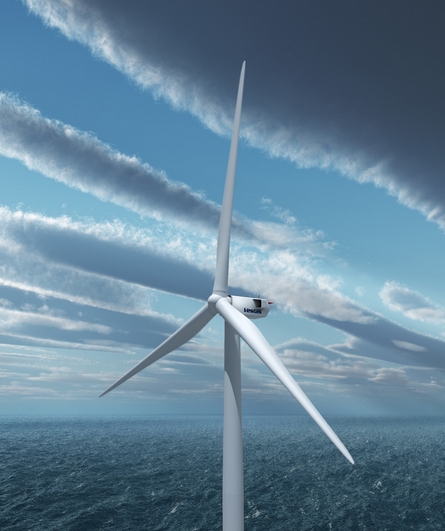Dec
23
More Work On Keeping Wind Energy Useful
December 23, 2020 | Leave a Comment
Twenty years ago, wind energy was mostly a niche industry that contributed less than 1% to the total electricity production in the United States. Wind has since emerged as a serious contender in the race to develop clean, renewable energy sources that can sustain the grid and meet the ever-rising global energy demand. Last year, wind energy supplied 7% of domestic electricity demand, and across the country – both on and offshore – energy companies have been installing giant turbines that reach higher and wider than ever before.

Artist Image of a Supersized Wind Turbine at Sea Amidst Contrails. Image Credit: Wiki Commons. Click image for the largest view.
Engineer Jonathan Naughton at the University of Wyoming, in Laramie said, “Wind energy is going to be a really important component of power production.” He acknowledged that skeptics doubt the viability of renewable energy sources like wind and solar because they’re weather dependent and variable in nature, and therefore hard to control and predict. “That’s true,” he said, “but there are ways to overcome that.”
Naughton and Charles Meneveau at Johns Hopkins University in Baltimore, Maryland, organized a mini-symposium at the 73rd Annual Meeting of the American Physical Society’s Division of Fluid Dynamics, where researchers described the promise and fluid dynamics challenges of wind energy.
In order for wind energy to be useful – and accepted – researchers need to design systems that are both efficient and inexpensive, Naughton said. That means gaining a better understanding of the physical phenomena that govern wind turbines, at all scales.
Three years ago, the U.S. Department of Energy’s National Renewable Energy Laboratory (NREL) brought together 70 experts from around the world to discuss the state of the science. In 2019, the group published grand scientific challenges that need to be addressed for wind energy to contribute up to half of the demand for power.
One of those challenges was to better understand the physics of the part of the atmosphere where the turbines operate. “Wind is really an atmospheric fluid mechanics problem,” said Naughton. “But how the wind behaves at the levels where the turbines operate is still an area where we need more information.”
Today’s turbines have blades that can stretch 50 to 70 meters, said Paul Veers, Chief Engineer at NREL’s National Wind Technology Center, who provided an overview of the challenges during the symposium. These towers tower 100 meters or more over their environs. “Offshore, they’re getting even bigger,” said Veers.
The advantage to building bigger turbines is that a wind power plant would need fewer machines to build and maintain and to access the powerful winds high above the ground. But giant power plants function at a scale that hasn’t been well-studied, said Veers.
“We have a really good ability to understand and work with the atmosphere at really large scales,” said Veers. “And scientists like Jonathan and Charles have done amazing jobs with fluid dynamics to understand small scales. But between these two, there’s an area that has not been studied all that much.”
Another challenge will be to study the structural and system dynamics of these giant rotating machines. The winds interact with the blades, which bend and twist. The spinning blades give rise to high Reynolds numbers, “and those are areas where we don’t have a lot of information,” said Naughton.
Powerful computational approaches can help reveal the physics, said Veers. “We’re really pushing the computational methods as far as possible,” he said. “It’s taking us to the fastest and biggest computers that exist right now.”
A third challenge, Naughton noted, is to study the behavior of groups of turbines. Every turbine produces a wake in the atmosphere, and as that wake propagates downstream it interacts with the wakes from other turbines. Wakes may combine; they may also interfere with other turbines. Or anything else in the area. “If there’s farmland downwind, we don’t know how the change in the atmospheric flow will affect it,” said Naughton.
He called wind energy the “ultimate scale problem.” Because it connects small-scale problems like the interactions of turbines with the air to giant-scale problems like atmospheric modeling, wind energy will require expertise and input from a variety of fields to address the challenges. “Wind is among the cheapest forms of energy,” said Naughton. “But as the technology matures, the questions get harder.”
Perhaps this work will aid in promoting even more wind energy growth for the industry. But one must remember, the issues not considered here are gaining ground. The “Not In My Backyard’ population is growing and getting angrier. The effect on crops for food and fuel production in the wind farms is far from answered and the data to date isn’t helping growth at all. The ideas for making the weather driven intermittency matter solvable seem to be massively expensive – something taxpayers and rate payers will likely rebel against. And the financial beneficiaries are the super rich politically connected.
Time will tell what the social cost turns out to be for what is really a niche production field to be taken to a major production industry. There is likely a point where a great idea for some becomes an economic threat for the many.

